#Best Indian Restaurants in Copenhagen
Explore tagged Tumblr posts
Text
Best Cities for Food Lovers Around the World

Exploring the best cities for food lovers can be a big task. Cities like New York, Tokyo, and Paris have street food and Michelin-starred restaurants. These places offer various food experiences that attract people from everywhere.
These cities are not just about the food. They are also about the culture and traditions that come with it. This makes them a must-see for anyone who loves to eat.
New York City, Tokyo, and Paris are famous for their lively food scenes. They mix traditional and modern dishes, showing off the city’s unique vibe. These cities have everything from casual spots to fancy restaurants. Whether you’re up for trying new foods or sticking to what you know, there’s something for everyone.
What Makes a City a Global Food Destination
A city’s fame as a global food spot comes from its unique culture and food traditions. Places known for great food attract both visitors and locals. They show how important it is to keep traditional dishes alive while trying new things.
Different kinds of places to eat are key, from fancy restaurants to casual spots and food trucks. This variety lets everyone find something they like. Cities like New York or San Francisco are great examples, offering everything from fancy meals to street food.
Cultural Heritage and Culinary Traditions
A city’s culture deeply influences its food. Keeping traditional cooking and ingredients alive is crucial. For example, Tokyo and Bangkok are famous for their street food, showing off local tastes and traditions.
Diversity of Dining Options
A city’s food scene mirrors its cultural mix. Having many types of food, like Italian, Chinese, Indian, and Mexican, makes it appealing. Paris and Rome are known for their food, offering unforgettable meals.
Local Markets and Street Food Scenes
Local markets and street food are a city’s culinary soul. They offer real, hands-on food experiences. Places like Austin and Portland focus on these, drawing food enthusiasts worldwide.
✈️💼🚕 Save time & money — book everything here now! 🏨��
Best Cities for Food Lovers Around the World: Top Asian Destinations

Asia is a food lover’s dream, with its lively global food hotspots and gourmet travel cities. Each city, from Tokyo’s busy streets to Bangkok’s night markets, has its taste and charm. Tokyo is known for its sushi, especially at the Tsukiji Fish Market, a top spot for foodies.
In Bangkok, the streets buzz with the smells and sounds of street food. You can find everything from spicy tom yum soup to sweet mango sticky rice. Seoul, meanwhile, is a gourmet travel city that highlights Korean BBQ, with favorites like bulgogi and bibimbap. These cities are global food hotspots and windows into Asia’s rich culture and traditions.
Asia caters to every taste, from spicy curries and kimchi to delicate sushi. With its diverse food culture, Asia is a must-see for food lovers. From well-known spots like Tokyo, Bangkok, and Seoul to hidden gems like Hanoi and Kuala Lumpur, Asia is full of culinary wonders.
🛫🏨🚗 Save time, save money — book all your travel here! 💼��
European Culinary Capitals and Their Signature Dishes

Europe is known for its rich food culture. Each region has its special dishes. From the Mediterranean to Northern Europe, it’s a paradise for food lovers.
Cities like Paris, Rome, and Barcelona are top spots for food. They mix old traditions with new flavors perfectly.
Mediterranean Food Havens
The Mediterranean is known for fresh seafood, olive oil, and veggies. These ingredients create some of Europe’s most famous dishes. It’s a perfect place for a food adventure.
Northern European Gastronomy
Northern Europe is all about hearty meals and creative use of local foods. You’ll find everything from German sausages to modern Nordic dishes here. Cities like Copenhagen and Amsterdam are must-visits for foodies.
Exploring Europe’s food scene is an adventure. Whether you’re in the Mediterranean or Eastern Europe, you’ll find something delicious. Europe’s rich food culture and innovative dishes make it a top destination for food lovers.
✈️🏨🚗 All your travel needs in one place — book now for less! 💰��
Conclusion: Planning Your Global Food Adventure
The world is full of amazing places for food lovers. From Asia’s lively street food to Europe’s famous culinary spots, there’s so much to explore. These destinations offer a chance to taste local flavors and dive into different food traditions.
When planning your food journey, be ready to discover new things. Visit bustling markets, try local specialties, and meet the food makers. Your taste buds will thank you with a world of flavors, making your trip unforgettable.
#FoodLoversGuide#CulinaryTravel#FoodieDestinations#GlobalEats#FoodieTravel#TravelForFood#GastronomyTourism#BestFoodCities#FoodAroundTheWorld#CulinaryAdventures#TasteTheWorld#FoodieParadise#FoodieCities#WorldCuisine#TravelAndTaste#FoodieExperiences#GlobalFlavors#StreetFoodAdventures#FineDiningWorldwide#EpicureanJourney#FoodiesAbroad#TopFoodDestinations#FoodieBucketList#WorldFoodTour#TravelAndDine#FoodieHotspots#CulinaryExploration#FoodieAdventures#FoodieWanderlust#EatTravelRepeat
0 notes
Text

Hervé This
Food has come a long way from grilling mammoths to using pills as food supplements. Every day, some food genius whips up something new with the million available ingredients and creates a new branch of gastronomy. We sample the end product, but don’t know about the hard work, research and technique behind the creations. Molecular gastronomy is one branch that has been gaining attention recently.
It sounds like something out of a science text book, and Chef Heston Blumenthal (of London’s finest restaurant, Fat Duck), who is one of the premiers of this form of cooking, agrees. He dislikes the term as “it makes the practice sound complicated and elitist”.
Most of us follow cook books and use the suggested ingredients and methods in the recipes. One day, Hervé This (pronounced ‘Tiss’) decided not to follow the recipe for a cheese soufflé, and instead of adding 2 eggs at a time (as directed by the recipe), he added all of them at once. Of course, his soufflé was an “epic fail” and that piqued his interest. “Why does adding 2 eggs at a time work?” Most of us would have blindly followed the instructions but Hervé, a physical chemist, decided to get to the bottom of this instruction. Thus in 1988 molecular gastronomy was born. Initially it was just the scientific research of culinary precision. A few years into the research, chefs realised that Hervé was on to something and that their food could benefit from it. Then it became a field combining science and food seamlessly and deliciously into mouth-watering dishes.
Even today, Herve reveals to the world the chemical or physical relationship of science with food. He publishes these discoveries every month in the Art et Science section of the website of Chef Pierre Gagnaire, one of France’s leading chefs. Some of his discoveries reveal that the perfect temperature to cook an egg is 65°C, that if some cold water is mixed with the egg whites while beating, they become foamier, and that there is a way to make 24 litres of mayonnaise with one egg.
He discovered how to unboil an egg. When an egg is cooked, the protein molecules unroll themselves, link up and enclose the water molecules. To uncook the egg, the protein molecules need to be detached from each other. By adding sodium borohydride, or vitamin C, the egg becomes liquid in three hours.
By performing these scientific miracles on food, Hervé gained the title ‘father of molecular gastronomy’ and is an idol for chefs around the globe who dabble in this form of cooking. The world’s best restaurant, located in Copenhagen, owned by Chef René Redzepi, prides itself on producing New Nordic Cuisine with molecular gastronomy influences. From this it is eveident that this is the direction future food is heading in.
Of the many avant-garde techniques used by these professionals, some can be reproduced by amateurs and beginners. For instance, one can use foam to decorate, and introduce a different texture to, a dish.
Another way of adding a surprise element to your dessert is by using popping candy. The snap and crackle of this candy at the bottom of a cheesecake or within a cupcake can be an awesome experience.
Spherification is another technique used by chefs. Here, you have the ability to give anything the appearance of caviar. This can be achieved by adding the chemical sodium alginate to any liquid, and then dripping the mixture into a calcium salt and water solution. It is best to scoop the little balls formed quickly so they have a jelly-like texture outside and liquid inside. These balls can be sweet (use fruit juices) or savoury (use consommé or stock).
One of the easiest tricks is adding fizz to your fruit. Add water to baking soda and citric acid until it begins to foam. Scoop it up and put it on pieces of your favorite fruit with a brush to experience the lovely zing in every bite!
By New Indian Express
1 note
·
View note
Text
Learn the Flavors of India at Bindia Copenhagen: The very best Indian Foodstuff In your area
In case you’re searching for reliable Indian food in your area in Copenhagen, glimpse no further than Bindia. Known for its flavorful dishes, vibrant atmosphere, and determination to quality, Bindia has earned a reputation as among the best spots for Indian cuisine in town.
A Style of India in Copenhagen
Bindia delivers the assorted and abundant flavors of India to the center of Copenhagen. No matter whether you're a fan of fiery curries, fragrant rice dishes, or savory tandoori solutions, the menu at Bindia delivers one thing for everybody. The cooks very carefully Mix standard Indian spices with fresh, community components to develop an unforgettable eating encounter.
What to anticipate about the Menu
Bindia’s menu is really a celebration of Indian culinary traditions. From common convenience foods to more exotic dishes, here are some have to-try objects:
Butter Rooster: Among the preferred Indian dishes globally, Bindia’s butter chicken is prosperous, creamy, and beautifully spiced. Paired with naan or rice, it’s a dish you won’t would like to miss.
Vegetarian Thali: For all those hunting for a variety of vegetarian delights, the Thali gives smaller parts of different dishes like dal, sabzi (vegetable curry), and raita, giving you a properly-rounded food.
Tandoori Chicken: Grilled in a conventional clay oven, this dish is recognized for its smoky taste and tender texture. It’s served with a refreshing salad and mint chutney for your refreshing equilibrium.
Paneer Tikka Masala: This vegetarian possibility is a crowd favourite. Comfortable cubes of paneer cheese are simmered inside of a tangy tomato-centered sauce, filled with robust spices that linger within the palate.
Samosas: These crispy, deep-fried pockets crammed with spiced potatoes and peas are fantastic as a starter or a light snack.
Vegan and Gluten-Free Options
At Bindia, there’s something for everybody, including those with dietary limits. They supply A selection of vegan and gluten-free of charge choices, making sure that each guest can appreciate a flavorful food. From vegetable curries to dairy-absolutely free naan, the restaurant accommodates diverse Tastes with no compromising on style.
The Atmosphere: A Combination of Custom and Modernity
Bindia’s ambiance brings together modern day Danish design with common Indian aspects, creating a cozy nonetheless up to date setting in your meal. The nice and cozy lighting and intricate decor insert for the authenticity of the practical experience, making it a super spot for both of those informal dinners and Distinctive events.
Takeaway and Supply Alternatives
For people who prefer to delight in Indian food near me in the comfort and ease of house, Bindia presents convenient takeaway and shipping solutions. You can order right as a result of their Web site or common food stuff delivery platforms, making certain you get a new and very hot food sent suitable to your doorstep.
Why Locals Adore Bindia
Bindia is more than just a restaurant; it’s a local favourite. With its welcoming personnel, continuously superior-quality meals, as well as a menu that caters to lots of tastes, it’s no wonder why so Lots of people return time and again. The cafe’s focus on sustainability and using natural and organic substances Any time probable also provides to its charm.
Ultimate Ideas
In the event you’re craving Indian meals and live in the vicinity of Copenhagen, Bindia could be the spot to be. Regardless of whether you're a lover of basic Indian dishes or desirous to explore new flavors, Bindia features an unparalleled eating expertise. Go to now to benefit from the wealthy, aromatic, and mouthwatering dishes which make Indian cuisine one of the earth’s most beloved culinary traditions.
Bindia Copenhagen: Your desired destination for genuine Indian food stuff near you!
0 notes
Text
Best resturent
Some of the Best Restaurants in the World
Noma (Copenhagen, Denmark) Frequently topping the list of the world's best restaurants, Noma is known for its innovative approach to Nordic cuisine. Led by chef René Redzepi, the restaurant has revolutionized the food scene by focusing on foraged ingredients, fermentation techniques, and an ever-evolving seasonal menu. Noma is renowned for creating dishes that are as artistic as they are flavorful, with a strong emphasis on sustainability and local sourcing. Dining at Noma is more than a meal—it's an exploration of nature, flavors, and culinary artistry.
Osteria Francescana (Modena, Italy) Chef Massimo Bottura's Osteria Francescana is often regarded as one of the finest Italian restaurants in the world. Blending traditional Italian recipes with modern techniques, Bottura has earned three Michelin stars and global recognition. Signature dishes like "Five Ages of Parmigiano Reggiano" showcase his creativity and respect for Italy's rich culinary history. The restaurant's dedication to reinventing classic Italian dishes while maintaining their cultural significance has earned it a loyal following.
Eleven Madison Park (New York City, USA) Located in the heart of Manhattan, Eleven Madison Park has garnered critical acclaim for its focus on contemporary American cuisine with a twist. The restaurant offers a multi-course tasting menu that highlights local and seasonal ingredients, with dishes that are both inventive and deeply rooted in tradition. Chef Daniel Humm's approach to fine dining emphasizes simplicity, balance, and flavors that reflect the city and its surroundings. Eleven Madison Park is also known for its stellar service and elegant ambiance, creating a luxurious yet comfortable dining experience.
Azurmendi (Larrabetzu, Spain) Chef Eneko Atxa's Azurmendi is celebrated not only for its outstanding Basque cuisine but also for its commitment to sustainability. The restaurant is housed in an eco-friendly building with its own greenhouse, where many of the ingredients used in the dishes are grown. Azurmendi offers a unique dining experience that begins with an immersive tour of the greenhouse and kitchen before guests sit down to enjoy the innovative tasting menu. The blend of tradition, innovation, and environmental consciousness makes Azurmendi a standout in the culinary world.
Gaggan (Bangkok, Thailand) Gaggan Anand's eponymous restaurant has been consistently ranked as one of the best in Asia. Known for its progressive Indian cuisine, Gaggan challenges traditional notions of Indian food by incorporating molecular gastronomy, creative presentation, and global flavors. The tasting menu, which often features up to 25 courses, takes diners on a whimsical journey through Indian culinary heritage, reinterpreted in bold and unexpected ways. The interactive and playful nature of the dishes adds an element of surprise and delight to the dining experience.
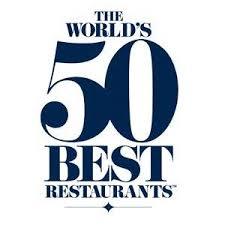
0 notes
Text
Culinary Odyssey: Discovering the Best Restaurants Around the World
Introduction:
Embarking on a gastronomic adventure is a journey that transcends mere dining; it is a tapestry woven with flavors, ambiance, and the artistry of culinary excellence. In every corner of the globe, exceptional restaurants beckon those seeking an extraordinary dining experience. In this article, we embark on a culinary odyssey to explore some of the best restaurants around the world, each offering a symphony of flavors that tantalize the taste buds and leave an indelible mark on the palate.
1. Osteria Francescana - Modena, Italy:
Nestled in the heart of Modena, Italy, Osteria Francescana is a culinary masterpiece helmed by Chef Massimo Bottura. Renowned for its avant-garde approach to traditional Italian cuisine, the restaurant has earned three Michelin stars and the title of "World's Best Restaurant." Osteria Francescana is a celebration of creativity, innovation, and a deep reverence for the rich culinary heritage of Italy.
2. El Celler de Can Roca - Girona, Spain:
In the picturesque city of Girona, Spain, El Celler de Can Roca stands as a beacon of culinary brilliance. The Roca brothers—Joan, Jordi, and Josep—curate a dining experience that fuses Catalan tradition with cutting-edge techniques. This three-Michelin-starred restaurant has consistently ranked among the world's best, offering an unforgettable journey through the flavors and textures of Spain.
3. Eleven Madison Park - New York City, USA:
Situated in the heart of Manhattan, Eleven Madison Park is a culinary jewel that has earned three Michelin stars and accolades as one of the finest dining establishments in the world. Chef Daniel Humm's innovative approach to contemporary American cuisine, coupled with impeccable service and a breathtaking Art Deco setting, creates an extraordinary dining experience that lingers in the memory.
4. Sukiyabashi Jiro - Tokyo, Japan:
Immersed in the bustling metropolis of Tokyo, Sukiyabashi Jiro is an intimate sushi haven that has achieved legendary status. With only ten seats and a dedication to perfection, this three-Michelin-starred restaurant, immortalized in the documentary "Jiro Dreams of Sushi," is helmed by Jiro Ono, an 95-year-old master sushi chef. Sukiyabashi Jiro is a pilgrimage for sushi enthusiasts seeking the epitome of craftsmanship and flavor.
5. Noma - Copenhagen, Denmark:
Renowned for its avant-garde Nordic cuisine, Noma in Copenhagen, Denmark, has been a trailblazer in the culinary world. Under the visionary leadership of Chef René Redzepi, Noma has earned multiple Michelin stars and accolades as one of the best restaurants globally. With an emphasis on foraging and local ingredients, Noma offers a distinctive and immersive dining experience that reflects the essence of the Nordic region.
6. Gaggan - Bangkok, Thailand:
In the vibrant city of Bangkok, Gaggan stands as a culinary force, redefining perceptions of Indian cuisine. Chef Gaggan Anand's eponymous Best Restaurants in Kuta Lombok has earned two Michelin stars and has consistently ranked among Asia's best. Gaggan takes diners on a gastronomic journey that blends traditional Indian flavors with molecular gastronomy, resulting in an explosion of taste and innovation.
7. Central - Lima, Peru:
Nestled in the culinary hotspot of Lima, Peru, Central is the brainchild of Chef Virgilio Martínez and his wife, Pía León. Celebrated for its elevation-inspired tasting menus, Central takes diners on a journey through Peru's diverse ecosystems, each course representing a different altitude. With its commitment to sustainability and innovative presentations, Central has earned its place among the world's top restaurants.
8. Disfrutar - Barcelona, Spain:
In the heart of Barcelona, Disfrutar, meaning "to enjoy" in Spanish, lives up to its name by delivering an exuberant and delightful dining experience. Born from the culinary minds of former elBulli chefs, Disfrutar has earned Michelin stars and acclaim for its inventive and playful approach to Mediterranean cuisine. The restaurant's avant-garde techniques and artistic presentations elevate dining to an immersive and joyous celebration.
9. Narisawa - Tokyo, Japan:
Tokyo's culinary landscape is enriched by Narisawa, a restaurant where traditional Japanese flavors harmonize with innovative techniques. Chef Yoshihiro Narisawa's commitment to sustainability and his deep connection to nature are reflected in each meticulously crafted dish. With multiple Michelin stars, Narisawa is a testament to the artistry of Japanese gastronomy.
10. Mirazur - Menton, France:
Perched on the French Riviera, Mirazur overlooks the Mediterranean Sea and offers a dining experience that mirrors the breathtaking views. Chef Mauro Colagreco's culinary prowess has earned Mirazur three Michelin stars and recognition as one of the world's finest restaurants. With an emphasis on locally sourced ingredients and a menu inspired by the surrounding landscapes, Mirazur is a sensory journey through the flavors of the Côte d'Azur.
Conclusion:
Embarking on a culinary journey to explore the best restaurants around the world is a passport to diverse flavors, innovative techniques, and the artistry of culinary visionaries. Each of these establishments weaves a narrative that transcends the act of dining, inviting guests to savor not just exquisite dishes but a profound celebration of culture, creativity, and the universal joy of enjoying exceptional food. Whether it's the avant-garde creations of Osteria Francescana or the immersive experiences at Central, these restaurants stand as beacons, beckoning discerning diners to indulge in the extraordinary world of gastronomy.
Source Url:-https://sites.google.com/view/elbazarlombokcom0/home
1 note
·
View note
Text
Best Restaurants in the World
Introduction
The world is a treasure trove of culinary experiences, with exceptional restaurants that take dining to new heights. These establishments are not just places to eat; they are destinations for food lovers and connoisseurs seeking unforgettable gastronomic journeys. In this article, we'll explore some of the best restaurants in the world, each known for its extraordinary cuisine, innovative chefs, and exceptional dining experiences.
1. Osteria Francescana (Modena, Italy)
Osteria Francescana, helmed by Chef Massimo Bottura, is renowned for its innovative Italian cuisine. It has been awarded three Michelin stars and has topped the list of "The World's 50 Best Restaurants." The restaurant combines traditional Italian flavors with avant-garde techniques, resulting in unique and delectable dishes.
2. Noma (Copenhagen, Denmark)
Noma, led by Chef René Redzepi, is famous for its reinvention of Nordic cuisine. With a focus on seasonal and foraged ingredients, Noma has held two Michelin stars and has been named "The World's Best Restaurant" multiple times. The ever-evolving menu showcases the essence of Scandinavian flavors.
3. Eleven Madison Park (New York City, USA)
Eleven Madison Park, under the guidance of Chef Daniel Humm, offers an unforgettable dining experience in the heart of New York City. With three Michelin stars, it is known for its contemporary American cuisine, impeccable service, and a menu that evolves with each season.
4. Mirazur (Menton, France)
Mirazur, situated on the French Riviera and led by Chef Mauro Colagreco, is celebrated for its inventive use of locally sourced ingredients. The restaurant has been awarded three Michelin stars and has been ranked among the world's best. It offers breathtaking views of the Mediterranean and a menu that reflects the region's culinary diversity.
5. El Celler de Can Roca (Girona, Spain)
El Celler de Can Roca, a three-Michelin-starred restaurant, is run by the Roca brothers. Known for its avant-garde Spanish cuisine, it has consistently ranked among the world's best restaurants. The establishment combines innovation with traditional flavors, offering a multisensory dining experience.
6. Central (Lima, Peru)
Central, under Chef Virgilio Martínez, is known for its elevation of Peruvian cuisine. The restaurant showcases the diversity of ingredients from various altitudes and ecosystems in Peru. It has received acclaim for its tasting menus that take diners on a culinary journey through the country's landscapes.
7. Gaggan (Bangkok, Thailand)
Gaggan, headed by Chef Gaggan Anand, has earned two Michelin stars and international acclaim for its modern Indian cuisine. The restaurant's inventive approach to traditional Indian dishes and its use of molecular gastronomy make it a must-visit for food enthusiasts.
8. Mugaritz (San Sebastian, Spain)
Mugaritz, led by Chef Andoni Luis Aduriz, is known for its avant-garde Basque cuisine. With two Michelin stars, the restaurant offers a highly experimental and creative dining experience, where flavors and textures are explored in innovative ways.
9. Disfrutar (Barcelona, Spain)
Disfrutar, a Michelin-starred restaurant in Barcelona, is co-led by three El Bulli alumni. It offers a playful and inventive take on Mediterranean cuisine, featuring a tasting menu that surprises and delights diners with unexpected textures and flavors.
10. Asador Etxebarri (Axpe, Spain)
Asador Etxebarri, led by Chef Victor Arguinzoniz, is celebrated for its mastery of wood-fired cooking. The restaurant has received one Michelin star and is known for its emphasis on high-quality, locally sourced ingredients, which are grilled to perfection.
11. Alain Ducasse au Plaza Athénée (Paris, France)
Alain Ducasse au Plaza Athénée, led by renowned Chef Alain Ducasse, has been awarded three Michelin stars and is celebrated for its modern French cuisine. The restaurant offers a sumptuous dining experience in an elegant setting, with an emphasis on sustainability and exceptional ingredients.
12. Pujol (Mexico City, Mexico)
Pujol, under the guidance of Chef Enrique Olvera, is known for its contemporary Mexican cuisine. The restaurant has earned a Michelin star and is celebrated for its reinterpretation of traditional Mexican flavors in a modern and innovative context.
13. The Ledbury (London, UK)
The Ledbury, led by Chef Brett Graham, has two Michelin stars and is recognized for its modern European cuisine. The restaurant offers a menu that reflects the best of British and European ingredients, resulting in a remarkable dining experience.
14. Attica (Melbourne, Australia)
Attica, under Chef Ben Shewry, has received international acclaim for its innovative Australian cuisine. The restaurant celebrates native Australian ingredients and offers a tasting menu that showcases the diverse flavors of the continent.
15. Quintonil (Mexico City, Mexico)
Quintonil, led by Chef Jorge Vallejo, offers modern Mexican cuisine with a focus on locally sourced and sustainable ingredients. The restaurant has been awarded one Michelin star and is celebrated for its creative and environmentally conscious approach to Mexican flavors.
Conclusion
The best restaurants in the world represent culinary artistry, creativity, and a deep commitment to exceptional dining experiences. Whether you seek traditional flavors reimagined, innovative culinary techniques, or the celebration of local ingredients, these restaurants offer a remarkable journey for food enthusiasts. Exploring the diverse and unforgettable cuisines at these establishments can be a transformative and unforgettable experience, making them a destination for epicurean adventures around the globe.
0 notes
Text
Central in Peru crowned as the World’s Best Restaurant 2023: Here’s the full list and some travel tips

Are you a foodie who loves to explore the best culinary experiences around the world? If so, you might be interested in the latest ranking of the World’s 50 best restaurants for 2023, sponsored by S.Pellegrino and Acqua Panna. The list was announced on June 20, 2023, at an awards ceremony in Valencia, Spain, and it features some of the most innovative and creative restaurants from different continents and cuisines.
The top spot went to Central, a restaurant in Lima, Peru, run by married chefs Virgilio Martínez and Pia León. Central’s tasting menu takes diners through the Peruvian ecosystem and its produce by focusing each course on specific altitudes. León’s restaurant Kjolle debuted on the list this year at No. 28. This also marks the first time a restaurant with a female chef has earned the top spot, and the first time a restaurant outside of Europe or the United States has won.
The second place was taken by Disfrutar, a restaurant in Barcelona, Spain, that offers a playful and avant-garde cuisine inspired by molecular gastronomy. The third place went to Diverxo, a restaurant in Madrid, Spain, that blends Spanish, Chinese, and Japanese flavors and techniques in an immersive and theatrical setting.
Other notable restaurants on the list include Alchemist in Copenhagen, Denmark, at No. 5, which serves a 50-course menu of experimental dishes in a futuristic dome; Maido in Lima, Peru, at No. 6, which specializes in Nikkei cuisine, a fusion of Japanese and Peruvian flavors; Lido 84 in Gardone Riviera, Italy, at No. 7, which showcases the regional ingredients and traditions of Lake Garda; and Atomix in New York City, USA, at No. 8, which offers a modern Korean tasting menu with artistic presentations.
The list also features some new entries and re-entries from different regions and cultures. For example, Trèsind Studio in Dubai, UAE, ranked at No. 11 as the highest entry for restaurants in the Middle East and Africa. Trèsind Studio serves an intimate and interactive Indian cuisine with a contemporary twist. Odette in Singapore ranked at No. 14 as the highest entry for restaurants in Asia. Odette is a French leaning tasting menu spot that uses Asian ingredients and influences.
Unfortunately, no Indian restaurant made it to the list this year. However, Indian cuisine did receive some recognition from other awards. Chef Garima Arora from Gaa in Bangkok, Thailand (No. 15 on Asia’s 50 Best Restaurants list) won the elit Vodka Asia’s Best Female Chef Award 2023. Chef Manish Mehrotra from Indian Accent in New Delhi (No. 18 on Asia’s 50 Best Restaurants list) won the American Express Icon Award 2023.
If you are curious about the full list of the World’s 50 best restaurants for 2023, you can check it out here. You can also watch the awards ceremony online here. And if you are feeling adventurous and want to visit some of these amazing restaurants yourself, you might want to check out some of these travel deals to the best restaurants.
I hope this draft helps you with your blog post. If you need any further assistance or feedback, please let me know. 😊
#food#recipes#cooking#baking#healthy#vegan#vegetarian#gluten free#dessert#chocolate#writers#news#director#worlds 50 best restaurants#fine dining#travel#foodie#peruvian food#spanish food#danish food#madscientistwriting
0 notes
Link
It is illustrated that like any other Copenhagen city, the city of Copenhagen is also home to some really cool places to eat. The restaurants in Copenhagen make sure that a traveller not only gets to taste the best of the local cuisine but also gets to enjoy the flavours of dishes belonging to some of the most global cuisines of Sri Lankanas well.

While on one hand are the Top restaurants in Copenhagen where one can sample the foods of Sri Lankan and all other things that the local cuisine is famous for, on the other are the best restaurants in Copenhagen namely at Taste of Lanka that are actually the fine dining restaurants serving a wide variety of cuisines.
In case if you are a passionate foodie traveller and happen to land up in Copenhagen, the Taste of Lanka is one of the best places in the city to try out a wide variety of delicacies belonging to cuisines from different parts of the world especially from Sri Lankan. Taste of Lanka adeptly welcomes foodies in a space which has chic decor and famous for offering an amazing array of global delicacies and Sri Lankan dishes as well. Everything ranging from the local favourite to the fancy foods is all available in the form of delicious items in this restaurant.
Why Taste of Lanka in Denmark is best Restaurant?
If people who are eagerly looking for the best Sri Lankan restaurant in Denmark, Sri Lankan restaurant in Copenhagen, Sri Lankan food in Denmark, Sri Lankan food in Copenhagen, Sri Lankan hotel in Denmark and Sri Lankan hotel in Copenhagen then you can try most popular one namely Taste of Lanka – Denmark.
#best indian restaurant in denmark#best indian restaurant in copenhagen#easy takeaway services in copenhagen#Best Indian Restaurants in Copenhagen#tasty indian food in denmark
0 notes
Text
Delicious Indian food restaurant in Denmark - Urban Indian
Are you looking for yummy, non-vegetarian Indian cuisine in Copenhagen? Urban Indian is the perfect choice for enjoying delicious Indian street food & cocktails. Our restaurant is situated in the heart of Copenhagen, with excellent public transport connections. We have a broad menu with a wide range of main courses including lamb, fish,chicken and vegetarian dishes. Walk into Urban Indian with your family, friends and colleagues and enjoy our uniquely curated dishes.
For More Details www.urbanindian.dk Ph : +45 91 93 91 93

#restaurant#best indian restaurant in denmark#indian restaurants in denmark#best indian restaurant in copenhagen#indian style restaurant in denmark#best takeaway service in copenhagen#best restaurants for corporate events in denmark#best indian foods in copenhagen
1 note
·
View note
Text
The Kitchen Recipes Restaurant Travel
Here's A Compilation Of Some Useful And Interesting Information On These Topics.
the kitchen recipes restaurant travel
Witch RECIPES?
Baked Chicken Parmesan: This Classic Italian Dish Is Made By Coating Chicken Breasts In A Breadcrumb And Parmesan Cheese Mixture, Then Baking Them In The Oven. Serve With Spaghetti And Marinara Sauce For A Delicious Meal.Chocolate Chip Cookies
: Who Doesn't Love A Warm, Gooey Chocolate Chip Cookie. This Recipe Is A Classic And Always A Crowd-Pleaser. Serve With A Tall Glass Of Milk For The Ultimate Comfort Food Experience.Roasted Vegetables
: Roasting Vegetables Is A Great Way To Bring Out Their Natural Sweetness And Enhance Their Flavor. Try Roasting A Mix Of Carrots, Brussels Sprouts, And Sweet Potatoes For A Healthy And Delicious Side Dish.
Spaghetti Carbonara: This Pasta Dish Originated In Rome And Is Made With Spaghetti, Eggs, Parmesan Cheese, And Bacon Or Pancetta. It's Rich And Creamy, And Perfect For A Cozy Dinner At Home. Homemade Pizza
: Making Your Own Pizza At Home Is Easier Than You Might Think. Start With A Basic Pizza Dough Recipe, Then Add Your Favorite Toppings Like Pepperoni, Mushrooms, And Onions.
the kitchen recipes restaurant travel
Witch Restaurants?
Eleven Madison Park
- New York City: This Three-Michelin-Starred Restaurant Offers A Fine Dining Experience Like No Other. Chef Daniel Human's Tasting Menu Features Inventive And Beautifully Presented Dishes That Are Sure To Impress.Osteria Frances can
- Modena, Italy: This Restaurant Has Been Named The Best In The World Multiple Times, And For Good Reason. Chef Massimo Innovative Approach To Italian Cuisine Is Both Playful And Thought-Provoking.Noma
- Copenhagen, Denmark: Noma Is Known For Its Focus On Local And Seasonal Ingredients, And Its Menu Changes Frequently To Reflect What's available. The Restaurant Has Been Awarded Two Michelin Stars And Has Been Named The Best In The World Four Times.Aline
- Chicago, Illinois: Chef Grant Avant-Garde Approach To Cuisine Has Earned Three Michelin Stars And A Reputation As One Of The Best Restaurants In The United States. The Tasting Menu Is A Sensory Experience That Is Sure To Leave A Lasting Impression.Bangkok, Thailand
: This Restaurant Serves Modern Indian Cuisine With A Twist. Chef Anand's Playful And Creative Dishes Have Earned The Restaurant Two Michelin Stars And A Spot On The List Of The World's 50 Best Restaurants.
the kitchen recipes restaurant travel
Witch Travel?
Paris, France: Known As The City Of Lights, Paris Is Home To Some Of The World's Most Famous Landmarks, Including The Eiffel Tower, Notre-Dame Cathedral, And The Louvre Museum. It's Also A Culinary Capital, With World-Renowned Restaurants And Cafe's Serving Everything From Croissants To Escargot.
Tokyo, Japan: Tokyo Is A Vibrant And Bustling City That Offers A Unique Blend Of Tradition And Modernity. From The Historic Temples And Gardens To The High-Tech Gadgets And Neon Lights Of The Shibuya District, There's Something For Everyone In Tokyo.
Marrakech, Morocco: Marrakech Is A City Of Contrasts, With A Mix Of Old And New, Traditional And Modern. Explore The Narrow Alleyways Of The Medina, Visit The Bahia Palace And The Saadian Tombs, And Take A Hot Air Balloon Ride Over The Atlas Mountains For A Truly Unforgettable Experience.
Bali, Indonesia: Bali is A Tropical Paradise With Stunning Beaches, Lush Forests, And A Rich Cultural Heritage. Visit The Ancient Temples. More Article
1 note
·
View note
Link
Exploring Denmark: Taking Pleasure in Danish Delights
Denmark – a place of happiness, a collaboration of new and old – the perfect place for any kind of traveller. From festivals, art galleries and botanical gardens to EDM raves and snazzy architecture… The country has something for all who choose to travel here! Hygge Ever heard of the term Hyyge? It’s pronounced “hoo-gah”, and translates roughly to ‘cosiness’. But really, Hygge goes far deeper than that: it embodies warmth, enjoying a comforting atmosphere and good people. Things like sitting under the sun reading a good book, cosying up with your family in front of the fireplace, going on a picnic… All of them are Hygge. And Danish people, unsurprisingly, have a lot of it. It’s a Danish way of life, and you’ll find it year-round – probably why Danes top the charts when it comes to quality of life. If you’re unsure of how to go about embodying this culture, they have Hygge and happiness tours that you and your family can embark on – maybe find yourself, and some new friends too!
A Cycling Country Danish people are crazy about cycling. The country is known for its intense biking culture, and you can travel on a cycle whenever and wherever. They’re freely available to the public, and are actually encouraged – if you fancy a romantic bike ride with cool breeze in your hair and the towering sights of Denmark’s coolest castles at your footstep, then cycling it is. Most of Denmark’s terrain is either flat or mildly angled, and the nation has an expansive network of cycle routes to explore as well. The best part is, you won’t feel even a tad bit out of place while doing it – more than 50% of Copenhagen travels by bike, so you’ll fit right in with the locals!
Quintessential Quadruple – Copenhagen, Aarhus, Odense and Aalborg These are the four biggest – and most popular cities in Denmark. Why, you ask? Well…
Copenhagen If we’re going to start talking about how amazing Copenhagen is, we need to start from the outside: it’s home island Zealand is just as (if not more) enticing as the actual city itself. Zealand is home to an insane amount of interesting man-made and natural spots that spark contemplation and curiosity upon sight – places like the Louisiana Museum of Modern Art, and the Frederiksborg Castle are a must-see for those interested in the culture and history of Denmark. Other man-made mini adventures include the Six Forgotten Giants (a treasure hunt in the midst of a forest for these 6 gigantic wooden sculptures), and Camp Adventure (a large cone-shaped monument that has a breathtaking view from the top). Copenhagen itself hosts a variety of eye-catching experiences, including their world-class zoo, aquarium, open air museums and range of galleries. The experimentarium hosts fun science interactions, and the Botanical and King’s Gardens are home to expansive glass domes filled with teeming flora.
Aarhus Aarhus – a city where Hygge embodies its natural surroundings, and seeps its way into the Danish creativity: giving rise to all sorts of amazing urban architecture. To pick 3 of the coolest architectural experiences in Aarhus isn’t hard at all – what’s hard is figuring out how not to want more! The ARoS Aarhus Art Museum is home to a walkway bridge-like contraption – nothing fancy, until you see it and realise it’s like walking through a rainbow. From the inside, it’s the perfect embodiment of La Vie En Rose – except you’re seeing the world with more than just one rose-tinted glass: there’s the whole spectrum of rainbow waiting! Another really interesting work of art is the Infinite Bridge. Originally a temporary addition to a 2015 Sculpture fest, it was brought back by popular demand and is now permanently placed in Aarhus’ Varna Beach. You don’t just get the pristine cove and luscious high-rise forestry here – this bridge is a loop, meaning you can walk endlessly around it while uncovering bits of Varna Beach’s multifaceted natural beauty at every round. Lastly, The Iceberg.“What’s so special about an iceberg”? Well, it’s actually not even one – Aarhus Ø’s waterfront has one of the coolest-looking establishments ever – and it’s totally functional, too! It looks like a giant, man-made round of icebergs, and is named aptly so.
Odense The island of Fyn (pronounced “foon”) is where Odense is situated. Home to an eclectic mix of literary and environmental wonder, Fyn is a must-see for those looking forward to a laid-back vacation in the depths of Denmark. It’s ideal for those wanting a leisurely cycle around the countryside, because the natural islandic seascape draws many who go there. It’s also hard not to miss one of the many castles that adorn this part of Denmark, and a peaceful visit to these royal structures is always on the cards: for starters, we recommend the renaissance-dated Egeskov Castle. It’s also the home of Hans Christian Andersen, and many a tribute is paid to the legendary literacist here: he even has a museum in his name, that holds up the prestige of his works.
Odense is a place to slow down and experience the true Danish spirit – its largest market, Rosengaardcentret (yes, we have difficulty saying that too) is a bustling mix of vibrant people and vintage surroundings. Odense is also the only place outside Sydney where you can try your hand at bridgewalking – this is your chance! Their assortment of bars, cafes, restaurants and public spaces are a great place to just hang out and take it all in. Not to mention the many festivals that take place here, including the magical Hans Christian Andersen Festival, the reputed Odense International Film Festival, and of course, the Magic Days Festival.
Apply Visa Online
Apply For France E Visa Online Apply For China Visa Online Apply For Dubai Visa Online Apply For Australia Visa Online Apply For Azerbaijan Visa Online Apply For Bahrain Visa Online for Indians Apply For Cambodia Visa Online for Indians Apply For Egypt Visa Online for Indians Apply For Malaysia Visa Online for Indians Apply For Zambia Visa Online for Indians
2 notes
·
View notes
Text
Some Notes on what the grown-ups are up to...(Part 1 | SnKimiko Related)
So hey, I am not quite tired yet but too tired to draw so welp, I guess we’re doing this instead.
Honestly, recently I’ve realized that I haven’t really explored the careers the canon characters pursue within in my Next Gen Fanfic. Which is mainly because I honestly haven’t thought that much about it but rather only ever held some rough ideas. There’s reasoning to that but that mainly has to do with myself but I don’t have to get into that in detail now. It’s a lot about the fact that I’m still a pretty young person with not the best understanding of how the world works yet...but I’m working on it!
So meep, I thought I could write down some actual notes for some info regarding what the canon characters are up to when “Shokugeki no Kimiko” takes place. I’m still a little unsure about them (so don’t be surprised if I eventually change things up later), so I’d gladly appreciate feedback honestly!
Anyway, that lengthy intro aside...let’s get into it, I guess ; 7 ;
-
Megumi
Megumi Aldini-Tadokoro, formerly just Tadokoro, lives in her hometown in Tohoku and took over the position as it’s head-chef after her mother retired. The news that a Totsuki graduate, and not just any graduate but a former Elite 10 member, took over the Ryokan certainly drove a lot of people to the place.
Megumi’s wisdom regarding hospitality and her outstanding talents in the culinary field ultimately improved the tourism of the region immensely. The Ryokan is praised for the traditional Japanese atmosphere, exquisite food and, of course, the welcoming atmosphere and the warmth with which the guests are welcomed with.
Given that her priorities are certainly the customers and building a relationship with them even if it is for only one day, Megumi always resigned off from opening another restaurant. She can’t be at all at the same time after all and in her mind it would make everything less personal. However it’s at a time where Megumi already earned a name for herself and instead of mocking her decision as “too limited” or “not enough vision”, she’s respected by the culinary world.
Despite the fact though that the Ryokan is her prime focus, she does help out her husband Isami with new recipe ideas or other advice for the Trattoria-Aldini-Branch whenever he asks her. She does help out in the restaurants themselves as well, once or twice a year. Which is always made out to be a great deal.
She often gets invited to various hotels throughout a year and occassionally, she’ll take the offer and arranges a special banquet for one night for the hotel’s guests to enjoy. It’s certainly always an event to behold and something that every hotel, she’s served so far, wears with pride.
She’s mother to three children, two sons and one daughter. The oldest son, Hiroshi Aldini-Tadokoro, is a current higschool first year in Totsuki and a member of the 115th Generation. Her two twin-children Nino and Maja Aldini-Tadokoro still visit a primary school in the local area. They will be part of the future 119th Generation of Totsuki.
Takumi
Takumi Aldini lives in Tuscany and is the head-chef of the original “Trattoria Aldini” where he grew up in. But it’s not just that...
With the help of his business-knowledgeable wife Ikumi and of course his loyal brother Isami, Takumi build a successful brand out of the Trattoria which expands all over the world, having restaurants in almost every noteworthy city. It’s, additionally, kept affordable. It’s not something that the normal middle-class man can eat in each and everyday but it certainly is something he can go to once in a while.
Takumi is managing the restaurants within the West, so mainly Europe and America. (Isami is taking care of the restaurants in the East)
At the same time, the original Trattoria keeps him busy as well given that as the first and original Trattoria it has a bit of a cult-status and is on every tourist’s To-Do list that comes into the area. Whenever Isami and his family come over to Tscany, things become even more lively as many foodies would kill for the opportunity to see the infamous Aldine-Family and especially the Mezzaluna-Siblings in action.
Takumi has one daughter with Ikumi: Mika Aldini, a student of Totsuki’s 115th Generation.
Alice
After her cousin Erina vanished alongside Soma, the Totsuki-Empire was eventually laid into the hands of the so-often-overlooked Alice Nakiri, making her the new headmistress of Totsuki once Senzaemon retired.
There were a few doubtful voices regarding Alice’s Election as new head of this enormous branch, as so many had always pictured Erina in that position. But over time, these voice where shut down as Alice managed to fulfill her job pretty well. Some of her strategies or ideas might sound eccentric or unconditional at first, but there’s always logic and a certain wisdom to them. Also, Alice always had a great understanding of what she wants and how to get it which does make her a solid, cunning and to-beware negotiator.
She also does a lot for the intellectual part of Totsuki by expanding it’s library, funding research projects in fields other than strictly cooking, diversify the range of languages taught on Totsuki...etc.
As her profession as Totsuki’s headmistress consumes her quite a bit, Alice was only able to open two restaurants: one in Tokyo, called “Snestorm” and one in Copenhagen, called “Yukidoke”. Both are reservation-only places where she serves her experimental and unique culinary ideas. Snestorm is more focused on Western ideas, so to speak, while Yukidoke is more Eastern-orientated.
She has two twin-daughters with her husband Ryo: Lola Nakiri and Mona Nakiri, both members of the 115th Generation of Totsuki. She and her family definitely remain the apex of Japan’s culinary landscape. They host a yearly Summer-Ball which is one of the grandest, biggest and most anticipated events for any person worth their salt within the culinary industry.
Akira
With the reputation of having survived Totsuki and ending up amongst the 10 best students backing him up, Akira opens four highly-successful restaurants over the years between his graduation from Totsuki and the current timeline of “Shokugeki no Kimiko”. Currently, he’s outlining plans for a restaurant in the US.
His first is called “Sona” and is located in Tokyo and also known as Akira’s “main restaurant” so to speak. Over the years it has grown into a small palace and its one of pricey but also praised restaurants within the city. Quite a few rich ladies would die to have their wedding taking place there, as one certainly feels like some sort-off Mid-East royal stepping into the place.
The second is called “Signum” and is located in Singapore. What’s special about this restaurant is that the menu changes drastically every year. The concept is basically that each year, Signum serves a different kind of cuisine. One year it’s Thai, the other it’s Indian, then it’s Turkish, then Malaysian and so on. Akira announces this year’s menu on each New Years Party hosted by the Hayamas in Sona.
The third is called “Solaris” and is located in Kairo. Akira got inspired to open it, because of his son’s enthusiasm regarding travels to Egypt. It serves mainly all different sorts of curry but also various specialities of Mid-Eastern cuisines.
The fourth is called “Lilac Garden” and it’s the first one to not start with an “S” and this one is more dedicated to his daughter. It’s located in Herakleion on Kreta. It’s honestly a bit more of a café and has a truly beautiful pavilion that offers an enchanting look on the sea. What’s noteworthy is that the entire place is decorated with all sorts of flowers.
Aside from being busy with restaurants, Akira does actually time to time support Alice’s more academic advances in Totsuki by teaching seminars. It’s a rare occurrence but whenever he does, a broad number of students come rushing.
He also found himself a little hobby in a little side-business as perfumer. Originally, he only wanted to construct a perfume for his wife Hisako as a little surprise for an anniversary and ended up thinking: “Why not make some money out of this?” While the perfume for Hisako of course is a Hisako-Only-Creation that will never make it into the public hands, he did bring 3 other perfumes to the market that sell pretty well.
Akira has two children with Hisako, a son and a daughter. The son, Akio Hayama, is part of the 114th Generation and a member of Totsuki’s current Elite 10. The daughter, Kaori Hayama, is part of the 115th Generation as well as it’s valedictorian.
#meep I tried ovo;;#I also wanted to do Hisako and Ryo...but now I did end up tired#but it would mean the world to me if any of you gave it a read ; 7 ;#I really hope I did okay#Shokugeki no Soma#Shokugeki no Kimiko Stuffz#Megumi Tadokoro#IsaMegu#Takumi Aldini#TakuIku#Alice Nakiri#RyoAli#Akira Hayama#AkiSako
37 notes
·
View notes
Text
The Best Pie of the Forgotten Realms
Let me tell you, this is probably the hardest I’ve ever worked to come up with a recipe, and the results are… well, you’ll see. Buckle up Wafflefam, it’s a long one. I can’t promise you it will be interesting, but I CAN promise you you’ll learn a lot about edible lichen.

The journey began with collecting what we canonically know about Jarlaxle’s pie: Chris called it a “Luskan fractal helix apple pie”, and its ingredients are common enough that you can find them already in Strix’s shop or in a Waterdhavian market, the two exceptions being Kara-Tur pears and a specific type of white, aquatic lichen that acts as a substitute to cinnamon. We also know that before getting the two secret ingredients, Strix was already working on the pie for about an hour or more; she then needed a performance check to successfully assemble it, and the pie baked “through the night”. Oh, and also, the pie is ultimately poisoned. More on that later.

The first thing I did was figuring out a “real world” counterpart to the secret ingredients, so that I could design the recipe around them rather than trying to cram them in a traditional apple pie.
The choice was easy for the Kara-Tur pears: Kara-Tur first appeared in the Oriental Adventures book for AD&D in 1985, and it doesn’t seem to have changed much since. As far as I can tell, the only mention of Kara-Tur in 5E is a brief paragraph in the Sword Coast Adventurer’s Guide, where it says that “Far to the east […] lie the empires of Shou Lung, Kozakura, Wa, and the other lands of the vast continent of Kara-Tur”. It’s probably a safe bet to assume these are the equivalent of our real-world China, Japan and Korea. So at least that’s easy to search: we need an Asian pear that is not that common in the West. You don’t have to look far to find the ideal candidate, the nashi pear; also called Asian pear, it’s grown almost exclusively in Japan, Nepal and China, and nowhere commercially in Europe or the US, which makes it a rather difficult fruit to find in the West. I also discovered when researching it that it was called “apple-pear” in several languages, so if that’s not a sign that it belongs in the best apple pie of the Realms, I don’t know what is. Now actually getting the nashi pears was kind of a pain, and after visiting several markets and shops and finding a big fat nothing, I gave up and ordered some online. Which, as you can imagine, makes it by far the most expensive ingredients that goes into the pie. I think I paid more for two pears than for all the other ingredients combined, but anyway, I’ll just be happy it fits into the theme of the rare and hard-to-get ingredient.

Let’s get to the white underwater lichen, shall we? Now THIS was a far more complicated treasure chase. At first I thought I could get away with using some kind of algae or seaweed, since there are so many edible ones, but nooo, that’s not what lichen is, you silly goose: it’s an organism made of types of fungi living in symbiosis with bacteria that use photosynthesis (most commonly algae). In other words, lichen is a moss-mushroom. A mossroom. This led me on a many-hours search of what types of lichen were edible, hoping against hope that I could just go and scrap some off of the trees and rocks in the forest nearby (spoiler alert: I couldn’t). I finally settled on three potential candidates for “best cinnamon substitute in pastry”: Umbilicaria, kalpasi, and Iceland moss.
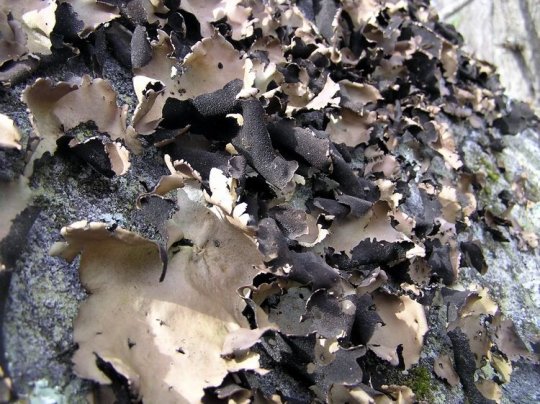
Umbilicaria (pictured above) is also called “rock tripe” in North America. It was a good candidate because, while not strictly aquatic, it does grow better on seaside cliffs and it is harvested in rainy weather. Its colours vary from black to light gray, so, that’s not white, but grayish could be close enough. I ultimately didn’t go with this one for another reason: it’s a delicacy in Japan, where it’s called “iwatake”, and that’s pretty much the only place where I could order some from. And it might seem petty, but I didn’t want the two secret ingredients to come from the same region of the world. There’s no fun in that.
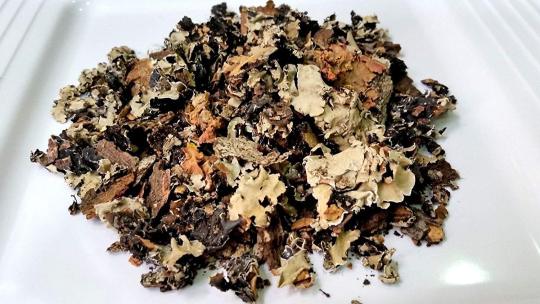
Kalpasi (above) also seemed like a good choice: it’s an Indian spice composed of ground up greyish-brown lichen, used in meat dishes. I liked it because, unlike other types of lichen, this one is supposed to actually taste good, with earthy, almost truffle-like tones. And we all know truffles always make a dish 50% fancier. For those interested, you can sometimes find it in the West in specialized shops, under the names kalpasi or dagad phool.
Coming down to the last one, Iceland moss! Despite its name, it is indeed a lichen and not a moss. I eventually settled on this one, for three reasons:
1) It’s not always white, but it can be.
2) It has been used as an unusual ingredient by the inventive chef René Redzepi in his two-Michelin-star restaurant Noma, in Copenhagen, considered one of the best restaurants in the world. The meals are… interesting, to say the least. Anyway, if it’s good enough to warrant two Michelin stars, we might as well use it.
3) As its name indicates, it grows in Iceland, more specifically on lava slopes. It’s not underwater, but I like the exoticism it brings to the table, in contrast to the other ingredients. Moreover, I don’t know how much of 4E has been retconned over the years, but I like the idea of Jarlaxle stumbling upon a rare type of white lichen on an ancient lava slope in Gauntlgrym just before he accidentally released Maegera (yes, the same one) and caused the eruption that destroyed Neverwinter. It gives a bit of flavor to the lichen, pun intended.
Here’s a picture of the bag I bought. It’s not the whitest, but it’ll do.
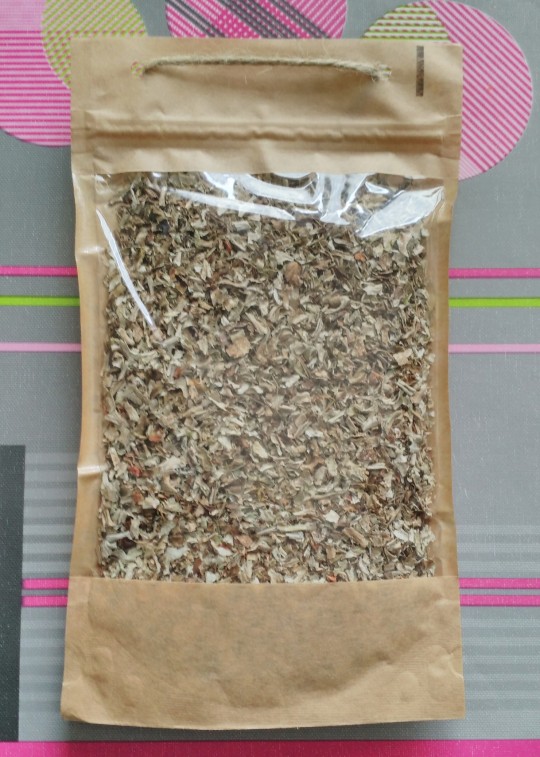
And there we are, the first step is done, we have our secret ingredients. For the more mundane ones, I went as “high-end medieval fantasy cooking” as I could:
- Waterdeep flour is most likely made in a traditional mill, probably water- or donkey-powered, so the flour I’ll be using comes from an abbey where it is made traditionally by monks who only sell it there. I’m not even joking. It’s an hour and a half away from where I live but I always make sure to pick up a few bags when I’m in the vicinity. It’s the finest flour I have ever seen, and I’m not exaggerating when I say it flows like water. The stuff is mesmerizing. Do you think they make flour in the Spires?
- The butter is also locally sourced from a dairy just outside my hometown, it’s partly made with the milk of cows I can see from my window. I don’t think the taste is that different from generic/industrial butter, but it’s as fresh as I can get, and I think that’s closer to what would be available in Waterdeep.
- Nothing much I can do about the powdered sugar, so it’s just store-bought. I could not find any mentions of sugar in official D&D sources, so I’m assuming they get the expensive one from Kara-Tur and they make the regular one from sugar beets, or that they use honey as a sweetener. We’ll just assume Strix gets hers from her Heward’s handy spice pouch, because we only need a small quantity of it.
- The eggs, on the other hand, come straight up from my grandma’s chickens. There are just 4 of them but their pen is bigger than her house and they eat like kings because the entire extended family feed them all their leftovers. I figure Strix probably raises her chickens the same way, or at least with the same amount of love. Their yolk is a bright yellow that you can’t get from anywhere else, and it makes for a good-looking pastry.
- Similarly, the apples come from my grandfather’s apple tree. It’s an exceptional tree that produces so much that 2 other varieties have been grafted on its trunk over the years; it now produces three different kinds of apple. We’re obviously a few months after the season though, so I’m using apples from Fall 2018 that were in my freezer. Not the freshest of ingredients, especially compared to the rest, but it’s the most “organic” apples I can get. I don’t think Waterdeep’s orchards use GMOs.

Now we need to find a way to make all of this into the best apple pie possible. On a sidenote here, I realize I’m not going to come up with the best apple pie ever out of the blue and simply by adding a strange fruit and an even stranger spice. My goal is for the pie to be the best it can be, while making it interesting enough so that a pie critic from the Forgotten Realms would be delighted enough to kiss a trash-tiefling.

First we need to figure out what Strix is doing to get the pie ready while her companions are fighting wererats and fishing treasure chests. I decided to use my tried-and-true crust recipe, which I have already posted here. It’s a bit long to make, as you need to make the dough, let it cool down for at least 30 minutes, and bake it blind for 10 to 15 minutes; that could be what Strix is doing during the hour+ when the others are away. It’s also way more buttery than most pastry recipes, and it’s a bit unusual in its use of powdered sugar, which I feel makes it closer to what the game’s recipe could be, because, well, it’s non-traditional. Given his choice of ingredients, Jarlaxle is obviously more on the disruptive side of baking.

Next, the filling. In my baking experience, I have found that apple pie is always better when the bottom is lined with applesauce: it keeps the crust from overcooking and keeps the apple slices moist for far longer, allowing you to cook the pie for the few minutes more that will turn crunchy apple bits into soft bites of caramelized goodness. The question now was, do I turn the nashi into purée and use that instead of applesauce, or should I use it as a fruit topping like an apple?
At first, I thought my supply of nashi pears would be very limited, so I would have to make them count. But once they showed up at my house, I realized my mistake: one pear weighs 800g (1.76 lb). These are heckin’ chonkers. Here they are, surrounding a normal-sized apple that wasn’t asking for any trouble:
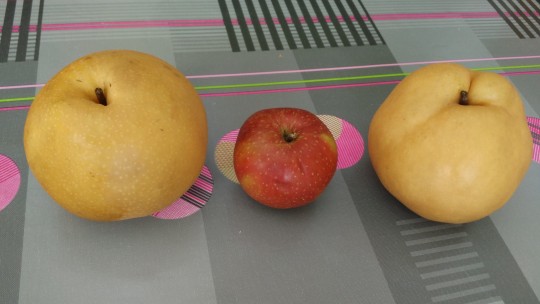
They’re as big as a grapefruit and four times as heavy. And the taste? Oh sweet Lathander, the taste. This is one of the juiciest fruit I’ve ever eaten. It feels like you’re eating a pear, but it tastes like a very sweet apple, with none of the tartness. It’s like a fruit for kids.
So, given that I had so much more fruit than I expected, I could try some experiments; I turned one half of a nashi into purée, and I baked a tray of mini-pies to try a few different combinations of fruit and sauce.

And here’s what I discovered –the nashi loses its taste when it’s cooked. There is absolutely no point in making an apple pie with nashi as a main fruit, because it’s like biting into a bland pear, which is a shame, given how delicious it is in its raw form. However, its juiciness makes it a pretty great ingredient for the purée. As I said, it loses its taste, so it doesn’t overpower the apples, but the texture of the “nashisauce” is everything you want in that kind of pie: it’s smooth, it’s moist, it ties everything together very well. So, I’ll count that as a win!

Now for the lichen. Chris/Jarlaxle said it was to be used as a substitute to cinnamon, so I had a few options: mix it in with the nashisauce, lightly coat the apple slices in it before assembling the pie, or dust the pie just out of the oven with grated lichen. At that point, you’re probably wondering what Iceland moss tastes like, and so was I. So I ate a bit of it. And regretted it immediately.

It is extremely bitter, and tastes like cheap tea. How do you turn that into an ingredient worthy of the best pie in Waterdeep? The first thing I tried was to let it steep in hot water, as if I was actually making tea. I made two cups: one to use the resulting water as a binding agent for the crust (which would imply reducing the amount of egg yolk, but you never know, it could be for the best), and one to see if I could “wash away” some of the bitterness off the lichen.
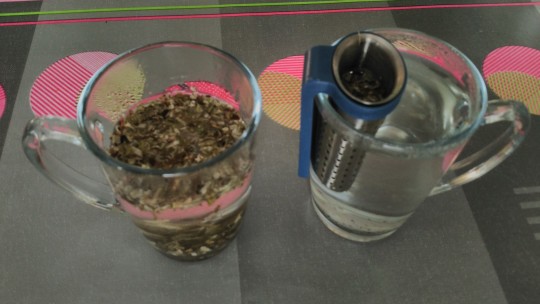
Well, again, no to both of those, it was just too bitter. But I discovered in the process that if you let the lichen steep in hot water long enough, it falls to the bottom of the cup and you can mush it into a kind of lumpy paste. Working from this, and after many tries, I finally came up with what I think is a good solution: I boiled the lichen in a lot of water with a few spoons of honey until it turned into mush, pressed that into a mold, baked it for half an hour, rolled the resulting paste into a ball with powdered sugar to reduce its stickiness, let it air dry overnight and well into the next day (I sped up the process by leaving it on top of my oven, which is often on in our home), and baked it once more at a very low temperature for almost two hours. The result was a very hard ball of cooked-but-unburnt lichen, honey and sugar, which I could grind into a sand-like powder.

Its only use in that state is to be scattered on top of the pie just out of the oven, which melts the sugar and frees the aroma of the lichen. Now here’s where it gets interesting: it’s sweet and the bitterness is still there, but it’s a good bitterness, like adding dark chocolate to curry or a red wine sauce. It’s not overpowering, it doesn’t overwhelm the apple taste, you don’t get it on every bite so you don’t get bored of it, and overall, it just tastes great. And that’s exactly what we want.
All right, everything seems to be figured out ingredients-wise, time to bake the first test pie! I was wondering what exactly would be the look of a “fractal helix pie”, so I just went with a pie-ception kind of concept and used once again my trusty mini-pie tray to make smaller pies on the main pie.

Also, I used an apple peeler and corer and only cut one side of the resulting product to turn the fruits into apple rings rather than the usual apple slices. I was hoping that it’d look more helix-y if I covered the pie in intertwined rings. Pop that in the oven for 50 minutes, and here we go!

So here are the results; it’s a good pie, all in all. The nashisauce certainly makes a difference for the best, albeit a small one –if you know it’s there, you can barely taste it, but if you don’t know it just feels like “hey, the applesauce did its job remarkably well today”. The lichen is also a welcomed addition on the bites where it is present, but you have to tell your guests that it’s there, otherwise their “Oh yeah, that’s pretty good in a dark chocolate-y kind of way” will turned into a shocked “What in the Nine Hells is that black stuff that tastes like a cursed grapefruit”.

Regarding the looks of the pie, it didn’t quite turn out as I’d hoped. Sure, it’s different, and the mini-pies-on-a-pie where a hit with the guests, but the apple rings had shrunk and broke off each other in several places, making it just a weirdly laid-out apple pie.

All in all, the first full-scale test was a bit disappointing, but not discouraging –the basics were there, and it was better than my usual apple pie. It just needed a little something to push it over the edge.
At this point, I’m thinking that the ingredients are pretty much the best we can realistically get, and I can’t imagine any cooking technique within my abilities that would improve the overall taste. So let’s add more ingredients and see if it does the trick. What can we add that doesn’t betray the lore of DCA and the setting of the Forgotten Realms?

Let’s dive back into the process: Strix has to bake her pies in a traditional bread oven, given that she worked in a bakery when she was a child. Which means her pies cook realistically in less than an hour in a very hot oven that stays around 250°C-275°C (480°F-530°F) all day. We’ve also seen in some episodes that the pies can be made and cooked in 10 minutes to half an hour, so she probably has a bunch of pre-cooked pastry case and keeps her oven above 300°C (570°F) , which is possible although quite insane.

But Chris said that the pie was let to bake overnight. How does that happen? Probably by baking the crust blind in the hot oven, which you typically don’t do for an apple pie, then take it out, let the temperature drop and the fire turn to embers, and finally putting the now assembled pie inside and closing the door so that the fruit slowly cooks and caramelizes. And what happens when you leave something in a semi-closed wood-fired oven for an extended period of time? It gets smoked. Literally. This is something I hadn’t thought of before, but every pastry made by Strix should have a very light woody, smoky aftertaste.
I don’t have access to a traditional baker’s oven (I’ve been planning on building one myself for years but never made the jump because I seriously doubt I could pull it off), but nowadays it’s easy to come by something called liquid smoke, which is exactly what it sounds like. So let’s get back to the mini-pie tray and bake some with different amount of liquid smoke, mixed into the applesauce or baked into the pastry.

And survey says: ooh boy you really don’t need much. If we extrapolate from the taste of the small pies, only about 5 drops should be added to the applesauce, and nothing to the pastry. It should give the pie that subtle smoky taste that hints toward campfire food. Any more and it tastes like the pie has been baked on an unwashed stove where you previously charred pounds of cheap, expired bacon.
Okay, we’re almost there… and then, as I was scraping my brain to find a new ingredient that would stay true to the pie, it hit me. It was staring at me right in the face from the very beginning.

It’s a LUSKAN pie. It’s from basically a pirate city! It needs rum to be complete! Again, there’s two way to go about this: either mix a big tablespoon of rum with the nashisauce, or pour it on the pie at the last moment to flambé it. But let’s be honest, flambé is just for show, and it will be much more flavorful if it bakes with the pie, so, let’s do that.
Also, I went back to Chris’s tweet announcing what the episode would be about, and he used this gif:

Soooo… Yeah, that’s probably why he called it a “fractal helix” pie. I don’t think I can replicate an ever-moving infinite pastry in real life, but I can certainly try.
Okay, let’s bake a new pie for real! This should be the one. I’m doing everything in one go, as close to DCA as I can:
1- Preparing the crust and baking it blind, undercooking it a lot, just enough so that there is no risk of the crust losing its integrity under the humidity of the nashisauce, while the rest of the Coven goes on a hunt for lichen and pears. Total time: 1 hour.
2- Beginning to cook the nashi into purée with half a vanilla pod (in a bit of last-minute inspiration) while peeling half of the apples; I am letting those oxidize for a bit, so that I’ll have two different colors of apple to work with. Time: 5min.
3- Boiling the Iceland moss with honeyed water and pressing the resulting paste into a mold: 15min.
4- Thoroughly blending the cooked nashi purée and setting it to cool down on the windowsill while the lichen bakes in the oven: 15 min.
5- Taking the lichen out of the oven and rolling it into a ball with powdered sugar: 5 min.
6- Mixing the nashisauce with liquid smoke and rum, peeling the rest of the apples, and finally assembling the pie in a pattern that suggests movement: 45 min. Yeah I went back and forth a lot with the placement and shapes of the apple slices. I’m thinking this is where the performance check comes into action, and I do not have proficiency in that skill.

7- And now, it has to cook overnight, while the ball of sweet lichen dries out on top of the oven. So what I’m doing is actually baking it at low temperature (175°C/350°F) for over an hour, and then, without ever opening the oven door to keep as much humidity inside as I can, turning it down to the smallest setting for another hour (that would be 100°C/210°F on my oven). Once this is done, I’m still not opening the oven door, and I turn the oven off, letting it cool down with the pie still inside overnight. Also I started it at 7PM, and now it’s a bit before midnight because I took my sweet time, so I’m going to sleep.

The next morning, I’m checking the ball of lichen: it’s not as hard as the first time, mostly because I didn’t let it dry long enough, but I should be able to grate enough of its surface to lightly dust it on the pie. Speaking of the pie, I’m finally opening the oven door, and… it looks perfect.

Or at least, it looks how I wanted it to look: the patterns are there, although some slices have shifted a little, and the two colors of apple give it a style that I absolutely love. I’m definitely using this trick from now on for my normal apple pies. And it’s still a bit warm. I’m taking the pie out and putting the lichen in on a very low setting to dry it out a bit more.
Four hours later, I am serving the pie; I popped it in the hot oven for a brief moment to slightly warm it up, grated a bit of lichen on top of it, and dug in with everyone.
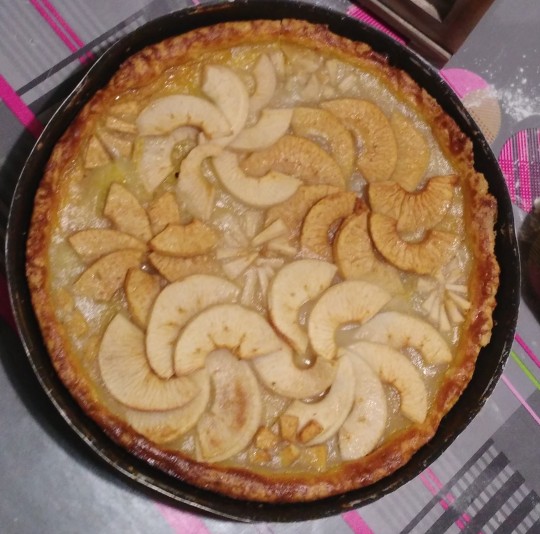
Is it the perfect pie? Probably not. Is it unusual? I mean, kinda, there’s a lot of subtle flavors in there that you don’t necessarily expect. Is it good? Yes, yes it is. The ingredients blend very well together. But more importantly, DID MY MOTHER SAY SHE LOVED IT AND ASK FOR THE RECIPE? DAMN RIGHT SHE DID. And that’s all I need to call it a success.

So here we are folks, this is the end of our Luskan fractal helix pie journey. I had a lot of fun coming up with that one, and I’m looking forward to the next culinary endeavors of the Chicken Foot Coven.
I guess that, as a conclusion, I need to address the biggest question we’re all asking ourselves: is this pie worth making?

If you just want to eat a good apple pie, no, not really. Just make your favourite apple pie, and maybe take some inspiration from this recipe to spice it up a bit. But if you want to try and bake it in the spirit of “let’s make a DCA-inspired pie”, please do. It’s tremendous fun. I loved tracking down and using those exotic ingredients, and the process of turning lichen into sweet sand makes you feel like an alchemist. Plus, it’s an easy recipe, there’s not much that can go wrong. It’s still just an apple pie.
All right, that’s it, we’re done. If you read everything, thank you so much for keeping up with my rambling. Don’t hesitate to ask if you have some questions related to all of that. Otherwise, I’ll see you all next time there is something to bake!
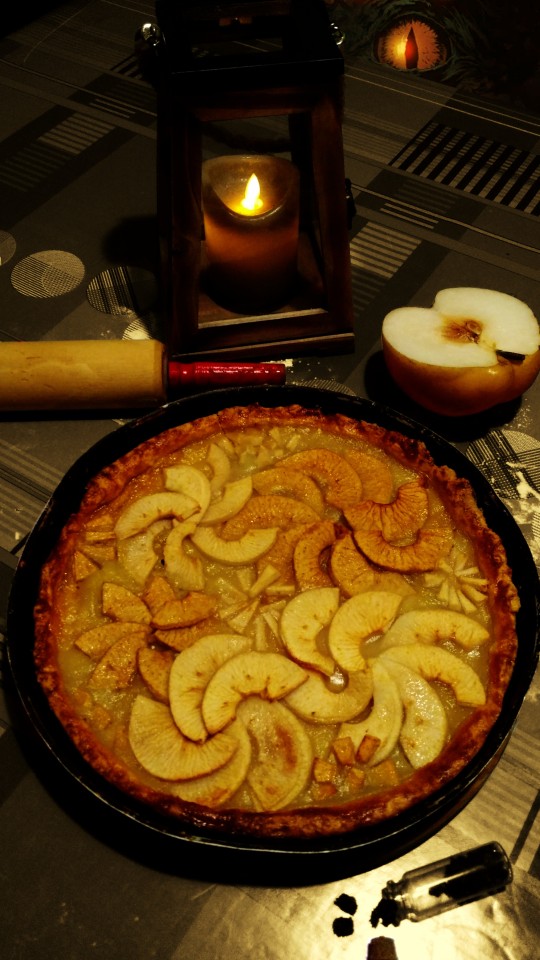
PS: “But what if I want to taste what the critic ACTUALLY ate, poison and all?”
So I did some research, and it seems that most poisons have a bitter taste, which is already present in our pie thanks to the lichen. So, potentially, the pie wouldn’t taste much different. I’d also wager that the Drow poison is tasteless. However, some “classical” poisons are known to have a distinct taste: cyanide supposedly tastes like bitter almonds, and poison hemlock allegedly tastes like mild parsnip. Yes, parsnip, you read that right. I don’t think parsnip will be a good addition to our pie’s flavor profile, but I’m positive that almonds will make it even better. If you’re not allergic.

15 notes
·
View notes
Text
LIFE AS AN INDIAN IMMIGRANT IN DENMARK
Life As An Indian Immigrant In Denmark
Are you planning to migrate to Denmark and wondering how would be life as an Indian Immigrant in Denmark? Here is a small preview for you before the immigration.

Denmark is a Scandinavian country situated in the Northern part of Europe. The Kingdom of Denmark, which is the smallest among all Scandinavian countries acts as a link between Scandinavia and the rest of Europe. There has been increased interest in living in Denmark as an Indian. To know how it will be to settle in Denmark, here we have unruffled some aspects of life in Denmark for Indians.
Employment In Denmark For Indians
Denmark is a welfare state and enjoys a mix of market and capitalist economies. The quality of life in Denmark for Indians is one of the best in the world. Denmark immigration enables you to enjoy life in a country, which frequently got counted among the happiest and most transparent countries in the world. Top Jobs in Denmark for Indians: The Denmark jobs for Indian potential job seekers are also extremely positive in corporate industries, tech companies, and small-scale businesses in Denmark. And, due to its geographical location, the export business is also one of the leading industries in Denmark.
[Read More: Application Process For Denmark]
Top list of Popular Graduate Jobs in Denmark:
IT Consultant Mechanical Engineer Radiographer Psychologist Primary and Secondary School Teacher Education Engineering IT Medicine & Health care services
If you are still looking for jobs in Denmark, check out the Sectors with Skill Shortage in Denmark:
High Demand Jobs In Denmark:
Doctors Medical Consultants Dentists Pharmacists Electrical Engineers Construction Engineers
Study In Denmark For Indian Students
Denmark has ranked as the 3rd best country to study in Europe as per the International Student Satisfaction Awards. More than 9 students out of 10 have stated that the high standards in education are the reason for student satisfaction in Denmark. Moreover, there are many benefits for Indians Students studying in Denmark.
Best Universities in Denmark in 2021-22:
University of Copenhagen Arhus University Technical University of Denmark Aalborg University
Minimum Cost Of Living In Denmark For An Indian Family
The cost of living for Indians in Denmark is higher than compared in India. But when compared to living in New York, it is a lot lesser. From groceries to rent, expenses are a little high when compared to other major nations like the UK, Australia, etc. Among all provinces, Copenhagen, the Capital City of Denmark has a low cost of living. Do you know Danish salaries are the second highest in the world? Yes, the highest paying jobs in the world are in Denmark. Lawyers, Bank Managers, and Chief Executive Officers are the highest paying professions in Denmark.
Language & Weather In Denmark
Denmark is a country with multiple islands and provinces. Danish is spoken in most parts of the country, while small pockets of French, English, Faroese, and Inuit are also in use. People who are living in Denmark as Indians can easily get along in the larger cities without any knowledge of Danish, as most people speak fairly good English in these cities. However, it is advisable to start learning the language to get the full experience of life in Denmark. Winters - Very Cold Summers Cold & Pleasant. [Read More: Why Denmark Is The Happiest Nation In The World?]
Food Choices In Denmark For Indians
Indians living in Denmark will not be able to find vegetarian food easily, though this is gradually changing. Several Indian restaurants are sprouting up in larger cities like Copenhagen. Many cities also have Indian grocery stores which stock Indian spices and other everyday cooking essentials such as basmati rice.
The quality of food in the country is excellent as it has the strictest food regulations in the world. There are many lovely treats for sweet lovers as Denmark is famous for its baked delicacies such as Danish pastry and open sandwiches.
Is Denmark Safe For Indians?
Denmark is safe for Indians because the people of Denmark are generally more reserved. They are not very gregarious but are always polite and helpful. Many of them step up to help you if you are lost and are looking for directions. Denmark is one of the happiest & safest places in the world, where women are treated on par with men in the country.
So, Indian Immigrants in Denmark enjoy a safe and secure environment as well as a high standard of living. To know more about migrating to Denmark, contact Global Tree at Begumpet, Hyderabad, one of the best Denmark immigration consultants and immigration advisors in India.
0 notes
Text
Best Gourmet Getaways // Hotels in Heaven®
Best Gourmet Getaways // Hotels in Heaven®
Michelin star restaurants, incredible locations and celebrity chefs. Here is a top 10 list of the best luxury gourmet getaways.

Jangala Dunhuang - Luxury Hotel in Dunhuang, China

Hilton Imperial Dubrovnik by Goddard Littlefair | Hotel interiors
Goddard Littlefair has completed the restoration of Hilton Imperial Dubrovnik, re-injecting golden age glamour into one of Europe’s most beautiful..

Studio Paradowski nods to Kraków's mid-century architecture in revamped Puro hotel

Bolza family turns 1,000-year-old castle into Hotel Castello di Reschio
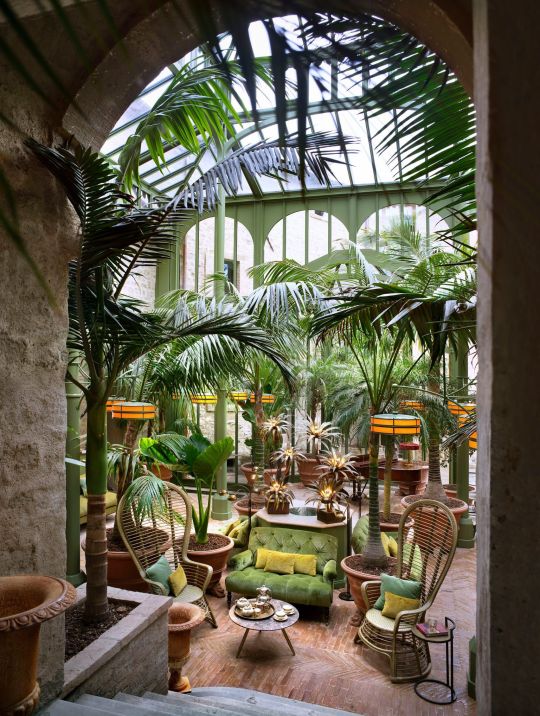
All grown up by Sebastian Lee / 500px

Surf Hotel Buena Vista CO - A Full Review of BV's Boutique Hotel
Surf Hotel Buena Vista | Our complete review of BV's Surf Hotel, and what it's like to stay in one of Colorado's prettiest boutique hotels.

DE&DE/Boutique hotel and restaurant design

Executive Lounge, Conrad Hotel by Brewin Design Office | Hotel interiors
Conrad Centennial Singapore was designed by Johnson Burgee Architects (NYC) and completed in 1996, and was part of a larger master plan of buildings that..

Terreo Studio Develops a Classical Yet Contemporary Residential Complex in Tulum, Mexico - Interior Design
Terreo Studio orchestrates every aspect of a classically inspired yet utterly contemporary residential complex in Tulum, Mexico—from the landscaping and lighting to the chill vibe

hotel room

Portofoliu Archive - Zebrano Romania - Luxury Philosophy

Ludovica+Roberto Palomba and GS Collection Transform a 19th-Century Puglia Home into a Boutique Hotel - Interior Design
For well-traveled Italophiles having already summered in the usual hot spots—Portofino, Positano, Capri—another, more remote locale beckons of late: Puglia, at the tip of the boot’s heel. It’s there, in the village of Gagliano del Capo, where the Adriatic and Ionian seas collide, that Palazzo Daniele, an ancient ancestral home transformed into a nine-suite hotel, is constituting a major draw.

Palazzo Dama - Rome's best luxury hotel
The Palazzo Dama luxury hotel is sitting right on the banks of the Tiber River. Vatican, Villa Borghese and Spanish steps are within walking distance. Best of all, the interior design hotel has its own pool.

Nobu Hotel London Portman Square - Make Architects
Make has designed the architectural concept and guestroom interiors for London’s latest Nobu Hotel. Located on Portman Square in Marylebone, the project has refurbished and extended an existing hotel formed of two towers atop a podium. David Collins Studio designed the communal interiors.

The Stratford by Space Copenhagen | Hotel interiors
The Stratford has opened with interiors, bespoke furniture and accessories by Danish design studio Space Copenhagen. The Stratford is a hotel located..

How Much to Tip Hotel Housekeeping
Here’s when, how, and how much to tip hotel housekeeping, according to industry and etiquette experts.

Lake Fuschl: A lakeside retreat in Austria’s Salzkammergut

Where to Stay in Manhattan: The Roger Smith Hotel - Rachel Off Duty
Wondering where to stay in Manhattan? Consider the Roger Smith Hotel in Midtown, an independently-owned property with spacious rooms.

Lasvit

Michelin stars, fantastic views, private locations and delightful delicacies. Are you looking for luxury hotels with incredible on-site restaurants? Indulge in various flavors and tempt your taste buds with the most exquisite cuisines of the planet. Here is our selection of the 10 best gourmet getaways that guarantee a delicious vacation. Share this list with your Friends Soneva Fushi Maldives The Soneva Fushi in the Maldives is well-known for its breathtaking location in the Indian Ocean and incredible restaurants. The ‘Out of the Blue’ restaurant offers an Asian and international cuisine. It includes an extra cheese room, a grill and pizza area. Enjoy one-of-a-kind views over the ocean while indulging in a culinary journey. Rosewood Castiglion del Bosco Italy The Rosewood Castiglion del Bosco is located in Tuscany, Italy. Enjoy a variety of different dining locations or learn how to cook Italian food in the cooking school ‘La Canonica’. The restaurants are nestled in a romantic and cozy spot with fantastic views over the valley. Waldorf Astoria Versailles - Trianon Palace France Michelin-starred dining, classic luxury and palace views. The Waldorf Astoria Versailles – Trianon Palace was built in 1907 and features different on-sites restaurants. Choose between the Gordon Ramsay au Trianon restaurant, La Veranda or Terrasse du Bar Galerie. COMO Cocoa Island Maldives Private dining at the beach, in-room dining or overwater restaurants. The COMO Cocoa Island Hotel offers some of the best dining options in the Maldives. Emirates One&Only Wolgan Valley Australia Located in the Greater Blue Mountains in Australia lies this gem – the Emirates One&Only Wolgan Valley. The Wolgan Dining Room provides personalized menus with local flavours. The Country Kitchen offers midday snacks or menus. Mandarin Oriental England The Mandarin Oriental Hyde Park is sitting between Royal Parkland and central Knightsbridge in London. The hotel runs three restaurants with two Michelin stars. This is for sure one of the city’s finest culinary destinations. The Peninsula Hong Kong Timeless glamour in modern Asia. The Peninsula Hotel in Hong Kong is renowned for its restaurant ‘Felix’. The restaurant clearly stands out with the stunning panoramic views of Victoria Harbour and its impressive menu. Marina Bay Sands Singapore The Marina Bay Sands is a landmark in Singapore. Its one-of-a-kind architecture features the world’s largest rooftop pool. The restaurants are well-known for many celebrity chefs, such as Gordon Ramsey, Daniel Boulud or David Myers. Andaz Tokyo Toranomon Hills Japan Luxury lifestyle in the centre of Tokyo. The 52-story skyscraper impresses with remarkable views of the city and its restaurants + bars. The Siam Bangkok Thailand Spacious suites, unique pool villas and signature dining options – the Siam Bangkok. The Chon Thai restaurant will bring only the freshest, finest local produce to your table.
0 notes
Text
Emily’s Pre-Prague World Tour
…And we’re off! My name is Emily Walker and I am a junior studying Computer Science through the CoE, studying in Prague this winter through Michigan’s brand new program: Computer Science and Tech Career Accelerator in Prague, Czech Republic.
I’m currently writing to you from Madrid, Spain, which is the last stop on my pre-trip world tour. I just spent the last 3 weeks living out of a carry-on and personal item exploring 6 countries before I head off to Praha.
Let’s rewind to the beginning of this new adventure. After hours of turning my suitcase into an intricate puzzle that only closes if you sit on it, filling my shoes with socks, and saying bye to my 4 dogs, I headed off to LAX for an 11 hour flight. For the entire car ride, my mind was racing with the anticipation of moving to Europe and traveling around with my family and friends. I was so anxious to leave, but the excitement to go abroad again and the fancy probiotic Ginger-Lemon Sparkling Olipop Tonic drink helped calm my nerves and my stomach.
I landed in Zurich and drove to Andermatt, Switzerland, for 3 days of skiing with my dad. The second I arrived, all of my nerves dissipated and I was filled with the adrenaline of skiing through the Swiss Alps. After 2 days of Off-Piste skiing with a full avalanche gear set-up, we headed over to Lech, Austria, for 2 more days of skiing there. We passed through Lichtenstien, the 2nd smallest country in Europe, for lunch, which landed at country #32 in my travel list.


These towns were the most beautiful and reminded me of a cute little snowglobe. Not only was the skiing amazing, but the cheese fondue had to be one of the best meals I’ve ever had… all 4 of the times I had it!

After 7 days in ski towns, we spent our last day on our father-daughter trip in Zurich. We did some great sightseeing, then I took a flight to London to spend the next few days with my friends who are studying abroad there. 3 of my roommates @ UMich are in London for the semester, and I haven’t seen them since we left Ann Arbor in December, so it was so great to see them. Studying abroad is crazy in that sense - I was with all of my friends in a foreign country!

We took a day trip to Oxford, and it reminded us of the British version of the Law Library in AA. While they were all in class, I spent my days wandering around London and meeting up with some other friends who live there full-time. My favorite day was going to Dishoom, an amazing Indian restaurant, followed by watching “Mamma Mia! Here We Go Again” the play.


After an amazing 5 days in London, the 4 of us headed to Copenhagen, Denmark, to visit our friend studying abroad there. I had never been to Copenhagen before, so this part of the trip was particularly exciting for me. We spent the cold Scandinavian days visiting the Copenhagen Contemporary museum and exploring the various neighborhoods, trying danish hotdogs from the best stand in Copenhagen and stopping inside coffee shops for some well needed Hygge-time (Hygge is Danish for describing a mood of coziness).

I had the most amazing time in Copenhagen, but I was getting ready to be settled in Prague by the end. Seeing all of my friends getting accustomed to their lives abroad made me both eager to arrive but sad to end my amazing Pre-Prague trip. But don’t worry! There’s 1 more stop: Madrid!
After running into some friends at the Copenhagen airport on their way to Madrid too, we all hopped in a cab and I made it to my friend Tara’s apartment in Sol. This part of the trip has been filled with delicious food and quality down time with my friends from Michigan, which has been a nice contrast to the go-go-go of the last 3 weeks of my life. I was recently in Madrid, so I took my time here to prepare for my arrival in Prague while seeing a more local side of the city - spending time in my friend’s favorite cafes and restaurants and accompanying them on their day to day lives here. Some highlights have included food, food, and more food…


Now that my trip has finally come to an end, I am ready to embark on this next adventure in my time abroad - getting to know Prague and all it has to offer! I can’t wait to get into the swing of things and start classes, explore more food, and meet new friends both from Michigan and Prague!
Talk to you soon, but next time in Praha!!
Emily Walker
Computer Science & Engineering
0 notes